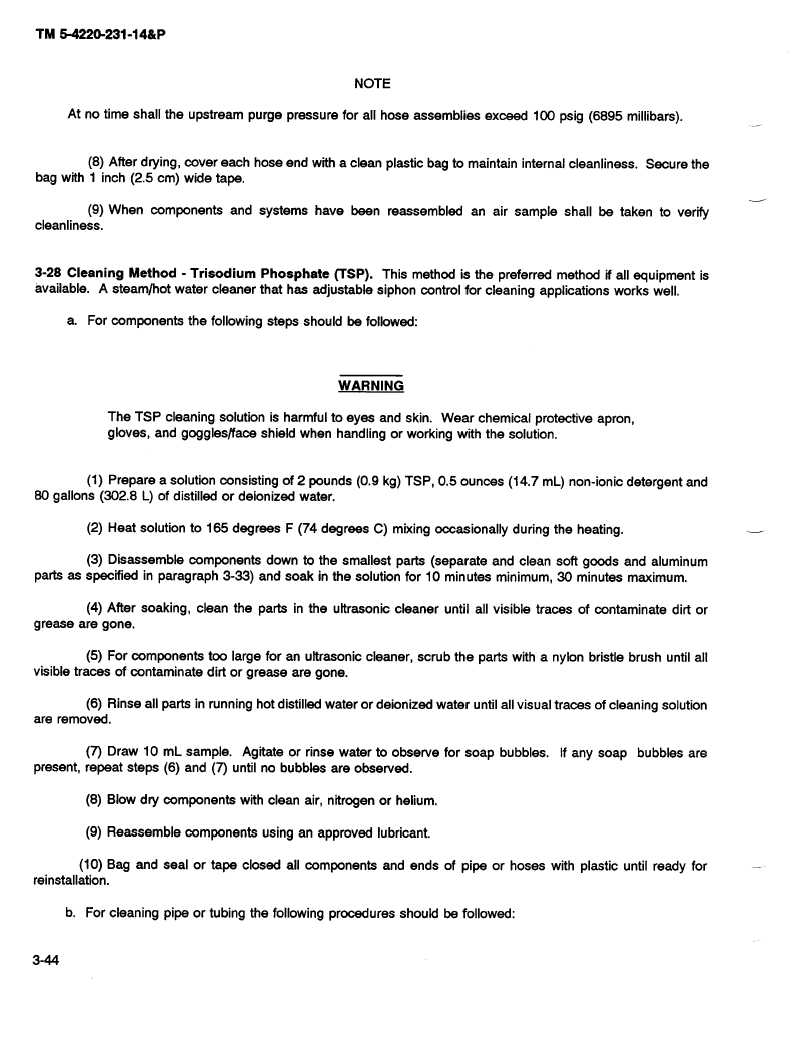TM 5-4220-231-14&P
NOTE
At no time shall
the
upstream
purge
pressure
for all hose
assemblies
exceed
100 psig (6895
millibars).
(8) After drying,
cover
each
hose
end with a clean
plastic
bag to maintain
internal
cleanliness.
Secure
the
bag with 1 inch (2.5 cm) wide tape.
(9) When
components
and
systems
have
been
reassembled
an
air sample
shall
be
taken
to verify
cleanliness.
3-28
Cleaning
Method
- Trisodiurn
Phosphate
(TSP).
This
method
is the preferred
method
if all equipment
is
Available.
A steam/hot
water
cleaner
that has
adjustable
siphon
control
for cleaning
applications
works
well.
a.
For components
the following
steps
should
be followed:
WARNING
The TSP
cleaning
solution
is harmful
to eyes
and skin.
Wear
chemical
protective
apron,
gloves,
and
goggles/face
shield
when
handling
or working
with the solution.
(1) Prepare
a solution
consisting
of 2 pounds
(0.9 kg) TSP,
0.5 ounces
(14.7
mL) non-ionic
detergent
and
80 gallons
(302.8
L) of distilled
or deionized
water.
(2) Heat
solution
to 165 degrees
F (74 degrees
C) mixing occasionally
during
the
heating.
(3) Disassemble
components
down
to the
smallest
parts
(separate
and
clean
soft goods
and
aluminum
parts
as specified
in paragraph
3-33)
and
soak
in the solution
for 10 minutes
minimum,
30 minutes
maximum.
(4) After
soaking,
clean
the
parts
in the
ultrasonic
cleaner
until all visible
traces
of contaminate
dirt or
grease
are gone.
(5) For components
too large
for an ultrasonic
cleaner,
scrub
the
parts
with a nylon
bristle
brush
until all
visible traces
of contaminate
dirt or grease
are
gone.
(6) Rinse
all parts
in running
hot distilled
water
or deionized
water
until all visual
traces
of cleaning
solution
are
removed.
(7) Draw
10 mL sample.
Agitate
or rinse
water
to observe
for soap
bubbles.
If any soap
bubbles
are
present,
repeat
steps
(6) and
(7) until no bubbles
are
observed.
(8) Blow dry components
with clean
air, nitrogen
or helium.
(9) Reassemble
components
using
an approved
lubricant.
(10) Bag
and
seal
or tape
closed
all components
and
ends
of pipe
or hoses
with plastic
until ready
for
reinstallation.
b.
For cleaning
pipe or tubing
the
following
procedures
should
be followed:
3-44

